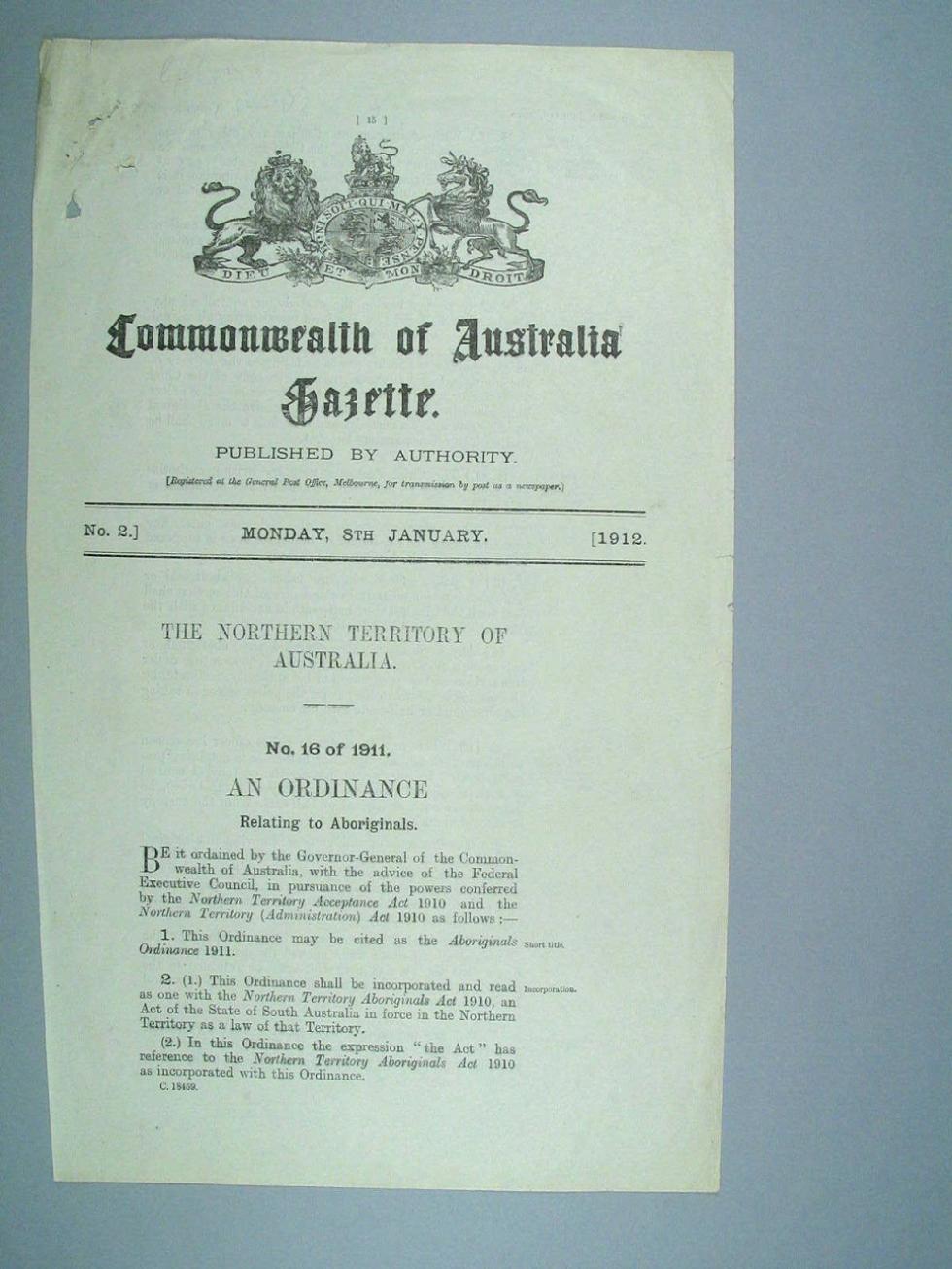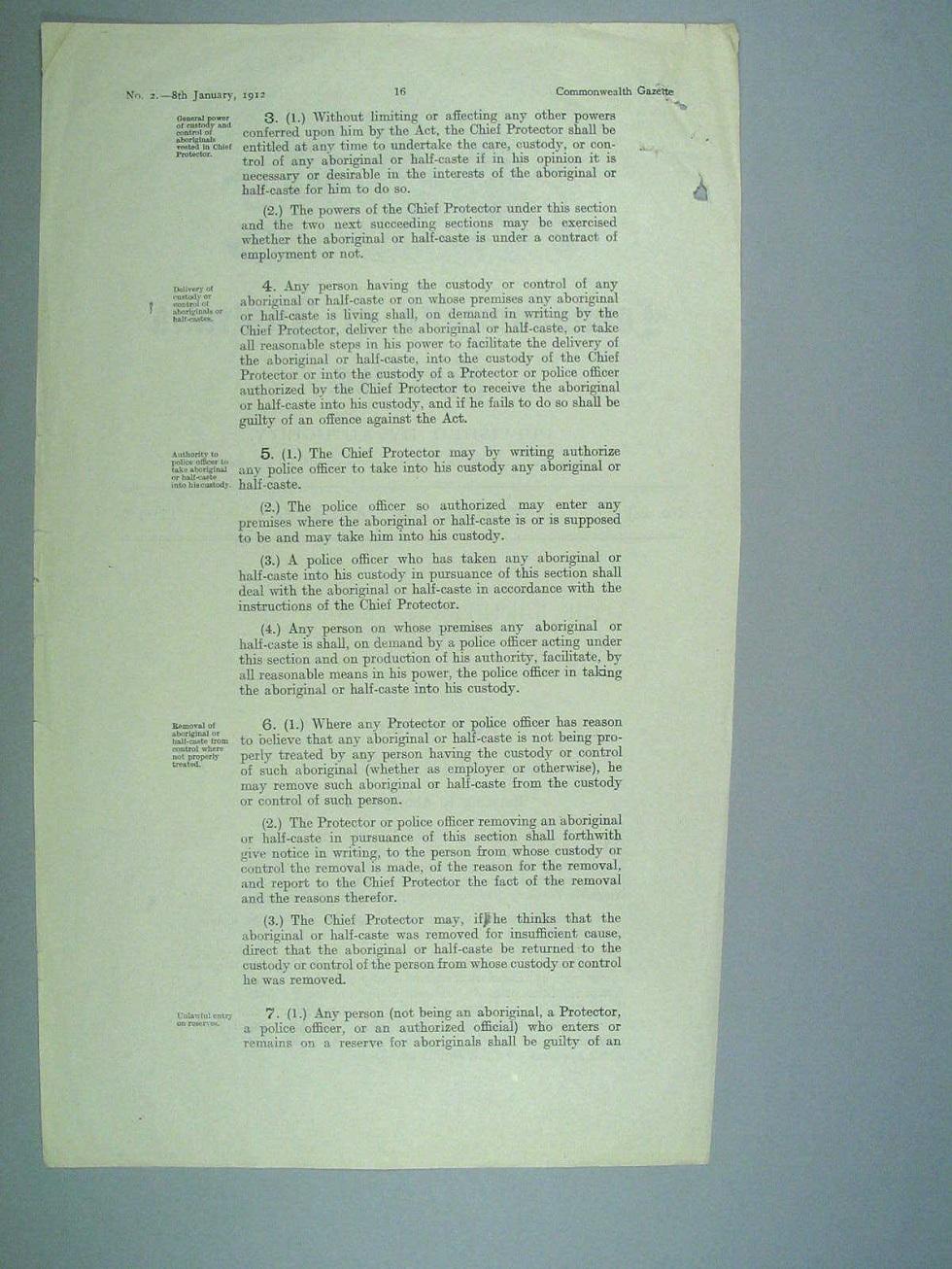

Aboriginal and Torres Strait Islander people should be aware that the National Archives' website and collection contain the names, images and voices of people who have died.
Some records include terms and views that are not appropriate today. They reflect the period in which they were created and are not the views of the National Archives.



[Page 1.]
[At the top of the page is the British Royal Coat of arms.]
[Title in bold, decorative font:] Commonwealth of Australia Gazette.
PUBLISHED BY AUTHORITY.
[Small, italics:] (Registered at the General Post Office, Melbourne, for transmission by post as a newspaper.)
[Dividing line.]
No.2.] MONDAY 8TH JANUARY [1912.
[Dividing line.]
THE NORTHERN TERRITORY OF AUSTRALIA.
[Dividing line.]
[Bold] No.16 of 1911.
AN ORDINANCE
Relating to Aboriginals.
BE it ordained by the Governor-General of the Commonwealth of Australia, with the advice of the Federal Executive Council, in pursuance of the powers conferred by the [italics:] Northern Territory Acceptance Act 1910 [end italics] and the [italics:] Northern Territory (Administration) Act 1910 [end italics] as follows :-
1. This Ordinance may be cited as the [italics] Aboriginals Ordinance1911. [end italics] [Right margin note reads: '(Short title)'.]
2. (1.) This Ordinance shall be incorporated and read as one with the [italics] Northern Territory Aboriginals Act 1910 [end italics], an Act of the State of South Australia in force in the Northern Territory as a law of that Territory. [right margin note reads: 'Incorporation'.]
(2.) In this Ordinance the expression "the Act" has reference to the [italics] Northern Territory Aboriginals Act1910 [end italics] as incorporated with this Ordinance.
C. 18459.
[Page 2.]
No. 2. – 8th January, 1912
16
Commonwealth Gazette
[Left margin note reads:] General power of custody and control of aboriginals vested in Chief Protector.
3. (1.) Without limiting or affecting any other powers conferred upon him by the Act, the Chief Protector shall be entitled at any time to undertake the care, custody, or control of any aboriginal or half-caste if in his opinion it is necessary or desirable in the interests of the aboriginal or half-caste for him to do so.
(2.) The powers of the Chief Protector under this section and the two next succeeding sections may be exercised whether the aboriginal or half-caste is under a contract of employment or not.
[Left margin note reads:] Delivery of custody or control of aboriginals or half-castes.
4. Any person having the custody or control of any aboriginal or half-caste or on whose premises any aboriginal or half-caste is living shall, on demand in writing by the Chief Protector, deliver the aboriginal or half-caste, or take all reasonable steps in his power to facilitate the delivery of the aboriginal or half-caste, into the custody of the Chief Protector or into the custody of a Protector or police officer authorized by the Chief Protector to receive the aboriginal or half-caste into his custody, and if he fails to do so shall be guilty of an offence against the Act.
[Left margin note reads:] Authority to police officer to take aboriginal or half-caste into his custody.
5. (1.) The Chief Protector may by writing authorize any police officer to take into his custody any aboriginal or half-caste.
(2.) The police officer so authorized may enter any premises where the aboriginal or half-caste is or is supposed to be and may take him into his custody.
(3.) A police officer who has taken any aboriginal or half-caste into his custody in pursuance of this section shall deal with the aboriginal or half-caste in accordance with the instructions of the Chief Protector.
(4.) Any person on whose premises any aboriginal or half-caste is shall, on demand by a police officer acting under this section and on production of his authority, facilitate, by all reasonable means in his power, the police in taking the aboriginal or half-caste into his custody.
[Left margin note reads:] Removal of aboriginal or half-caste from control where not properly treated.
6. (1.) Where any Protector or police officer has reason to believe that any aboriginal or half-caste is not being properly treated by any person having the custody or control of such aboriginal (whether as employer or otherwise), he may remove such aboriginal or half-caste from the custody or control of such person.
(2.) The Protector or police officer removing an aboriginal or half-caste in pursuance of this section shall forthwith give notice in writing, to the person from whose custody or control the removal is made, of the reason for the removal, and report to the Chief Protector the fact of the removal and the reasons therefor.
(3.) The Chief Protector may, if he thinks that the aboriginal or half-caste was removed for insufficient cause, direct the aboriginal or half-caste be returned to the custody or control of the person from whose custody or control he was removed.
[Left margin note reads:] Unlawful entry on reserves.
7. (1.) Any person (not being an aboriginal, a Protector, a police officer, or an authorized official) who enters or remains on a reserve for aboriginals shall be guilty of an [… end of displayed record.]
This is the Aboriginals Ordinance Act 1911. This law, which applied in the Northern Territory, sets out the powers of the ‘Chief Protector’. These powers were broad and included the power to remove First Australians from their families.
In 1911, the Australian Government took responsibility for the Northern Territory, which had previously been governed from South Australia. The first piece of Northern Territory legislation passed by the Australian Government was the Aboriginals Ordinance Act 1911. This law, together with the earlier South Australian Northern Territory Aboriginals Act 1910, established the Northern Territory Aboriginals Department and the role of the Chief Protector, who had sweeping powers over all aspects of the lives of First Australians in the Northern Territory.
The Chief Protector was empowered to ‘undertake the care, custody or control’ of every First Australian child and could forcibly remove First Australian children from their families and communities. First Australian children were sent to live in government institutions, in missions or with white families, where they were forced to assimilate into white society and speak only English—disrupting the transmission of language and culture.
Legislation of this sort applied across Australia, and the 1997 Bringing Them Home report found that, between 1910 and 1970, between one in three and one in ten Indigenous children had been taken from their families. The loss of these ‘Stolen Generations’ caused trauma that affects First Australian communities to this day. The report recommended that the Australian Government deliver a national apology to Australia’s Indigenous Peoples, and in 2008 Prime Minister Kevin Rudd apologised for ‘the law and policies of successive Parliaments and governments that inflicted profound grief, suffering and loss’.
Learn how to interpret primary sources, use our collection and more.
